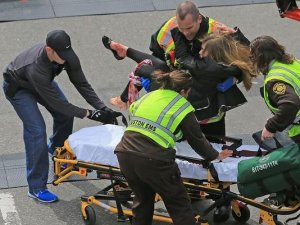Blast injuries from terrorist bomb attacks can sometimes lead to
unique and unusual patterns of injuries. These injuries are even classified differently from military-type wounds encountered by soldiers on the battlefield. Bombs, especially improvised explosive devices created by terrorist groups, often inflict simultaneous internal and external bodily damage which can cause morbid life-threatening multiple system injuries and possibly even death.
Effects of blast injuries
Blast injuries are the result of quick and rapid succession of chemical conversion of various pressurized solid and liquid gasses that instantaneously compresses the surrounding atmospheric air which generates what is known as a pressure pulse which quickly spreads as a blast wave in all directions. The effects of the blast wave are several times much more intense in a confined space such as a building of a vehicle. If the blast on the other hand occurs on an open space, the blast wave will instantaneously dissipate.
Different pattern of blast injuries
Blast injury patterns are highly dependent on different variables such as the amount of explosives, environmental conditions/setting and the type of explosive device that was used. Blast injuries should always be suspected by health care responders no matter how far a victim was in the epicenter of the explosion.
Most injuries are non-critical that mostly affect soft tissues and the skeletal system. Head injuries account for almost 70% or recorded deaths. Most blast lung injuries cause immediate death following the incident. Injuries include primary blast injuries, serious penetrating injuries, solid abdominal injuries and serious intracranial injuries. Bombing incidents that include structural collapse, victims often experience inhalation injuries, crushing injuries and fractures as a result of falling debris and heavy materials crashing down on them. Moreover, bombings that occur in tight and confined spaces causes a higher incidence of blast lung injuries, tympanic membrane rupture, partial and full thickness burns as well as hepatic or splenic injuries. On the other hand open space explosions often produce penetrating soft tissue injuries caused by shrapnel.
The shock waves from an explosion adversely affect and damage tissues and organs in various different ways. The following are four mechanisms of impact:
- Implosion – caused by trapped gasses contained in hollow organs such as the stomach and bowels which compresses and expands causing them to rupture.
- Spalling – caused by a shock wave moving in-between soft tissues of varying densities that is evident in the lungs or similar internal organs.
- Shearing – caused when tissues with different densities abruptly respond to movement at different speeds.
- Irreversible work – caused by external forces that exceeds the tensile strength of the injured tissue.
Special considerations when managing blast injuries
Blast injuries that involve pregnant victims will need special consideration. Although direct injuries to the fetus is uncommon, but injuries to the placenta are highly probably that must be assessed and detected as promptly as possible. Moreover, pregnant women in their second and third trimester, involved in an explosion or bombing incident should immediately be admitted to the labor and delivery area for continuous evaluation and monitoring.

Majority of bombings occur in public and densely populated areas with a diverse population speaking multiple languages of different ethnicity and cultural groups. The language barrier may prove to be an unforeseeable obstacle health care responders will have to consider. Other similar obstacles in treating blast injuries include victims that are deaf, hard of hearing the mute similarly disabled victims.

